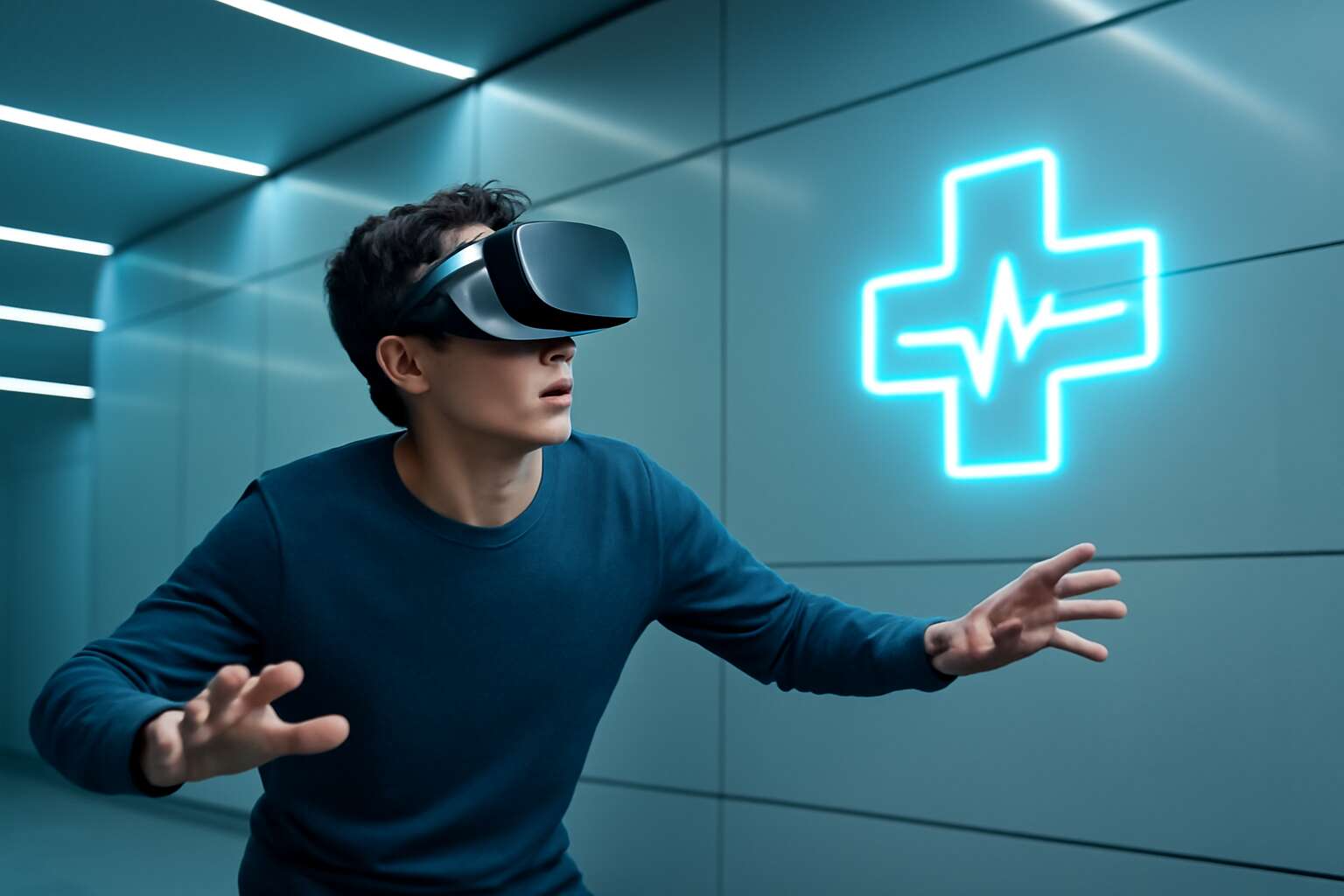Understanding Virtual Reality and Its Popularity
Overview of Virtual Reality Technology
Virtual reality has transformed the way we experience digital worlds, immersing us in environments that blur the line between imagination and reality. Its popularity has surged worldwide, captivating millions with the promise of adventure, education, and entertainment. But beneath this enchanting facade lies a question that often lingers in the minds of users: can virtual reality cause vertigo? This concern is not unfounded, as the sensation of dizziness or disorientation can sometimes accompany VR experiences, especially when the technology pushes the boundaries of our spatial awareness.
Understanding virtual reality involves recognizing its core technology—sophisticated headsets and motion sensors that track our movements, creating a convincing illusion of presence in a digital realm. Its rapid evolution has made it more accessible and compelling, yet also more capable of triggering physical reactions. The immersive nature of VR can sometimes disrupt our inner balance, leading to symptoms such as vertigo or nausea. For some, the sensation is fleeting; for others, it can be more persistent, raising questions about safety and design.
As VR continues to grow in popularity, researchers and developers are paying closer attention to its effects on the human body. They are exploring ways to minimize discomfort through improved hardware, software adjustments, and user guidelines. Whether for gaming, training, or therapy, understanding the potential for virtual reality to cause vertigo remains essential in harnessing its full potential without compromising well-being.
Growth and Applications of VR
Virtual reality’s rapid rise is transforming industries from gaming to healthcare, offering immersive experiences that were once unimaginable. Its ability to transport users to alternate worlds has captured the imagination of millions in South Africa and beyond. This surge in popularity is driven by advancements in hardware and software, making VR more accessible and realistic. As more people engage with virtual environments, questions about its safety naturally follow—specifically, can virtual reality cause vertigo? Understanding the technology’s core helps clarify why some users experience dizziness or disorientation during or after VR sessions.
VR’s applications extend beyond entertainment; it’s increasingly used in training simulations, therapy, and education. These varied uses demonstrate its versatility, but also highlight the importance of addressing potential health concerns. For example, some users report temporary vertigo or nausea, which underscores the need for improved design and user guidelines. As the technology continues to evolve, researchers are exploring ways to minimize these adverse effects, ensuring VR can be enjoyed safely by all.
Immersive Experiences and User Engagement
Understanding virtual reality is like peering into a shadowed mirror—reflecting a world that feels almost tangible yet remains elusive. Its allure lies in the immersive experiences that beckon users to step beyond the mundane, into realms crafted by digital dreams. As the technology advances, so does its popularity, captivating audiences across South Africa and beyond, eager for sensations that blur the line between reality and illusion.
For many, virtual reality offers a portal into uncharted territories—whether it’s exploring ancient ruins, battling fantastical creatures, or undergoing life-changing therapy. The engagement is visceral; the sensation of presence so convincing that it mesmerizes and immerses simultaneously. But with this heightened involvement comes a lingering question: can virtual reality cause vertigo? It’s a mystery wrapped in the shadows of human perception, where the mind’s delicate balance can be disturbed by the virtual’s seductive pull.
What Is Vertigo and Its Causes
Definition of Vertigo
Vertigo is a perplexing sensation—like the world tilts and spins without warning, leaving one disoriented and often unsteady. It’s a symptom, not a disease itself, that signals disruptions within the delicate labyrinth of our inner ear or brain. When the balance system falters, the mind perceives motion where there is none, creating that unsettling feeling of dizziness.
So, what causes vertigo? A multitude of factors can stir this swirling storm. Inner ear infections, benign paroxysmal positional vertigo (BPPV), migraines, and even certain medications are common culprits. Interestingly, the rise of immersive technologies has sparked curiosity about whether virtual reality can cause vertigo. While VR can trick the brain into perceiving movement, it also risks overloading the sensory pathways, potentially leading to vertigo in some users.
Common Causes of Vertigo
Vertigo is more than just a fleeting feeling of dizziness; it’s a mysterious and often unsettling perception of motion where there is none. When the delicate balance system within our inner ear or brain becomes disrupted, the result can be a disorienting whirl of sensations. This condition can strike unexpectedly, leaving individuals clutching at their surroundings, unsure of their footing. But what triggers this perplexing phenomenon?
Several common causes can stir the storm of vertigo. Inner ear infections, benign paroxysmal positional vertigo (BPPV), migraines, and certain medications are well-known culprits. Interestingly, with the rapid rise of virtual reality technology, questions have emerged about whether immersive VR experiences can cause vertigo. Because VR can trick the brain into perceiving motion, it often overloads the sensory pathways, especially in susceptible individuals. This leads us to wonder: can virtual reality cause vertigo in users, particularly during prolonged or intense sessions?
Symptoms and Effects
Vertigo, a swirling enigma that distorts our perception of stability, can be as fleeting as a whisper or as relentless as a storm. It manifests through a cascade of symptoms—dizziness, disorientation, nausea—that leave individuals grasping at shadows of normalcy. But what stirs this unsettling brew within our inner sanctum? At its core, vertigo often arises from disruptions in the delicate labyrinth of the inner ear or the complex pathways within the brain. These disturbances can be triggered by a variety of factors, ranging from infections and migraines to certain medications, each capable of unsettling the equilibrium that keeps us grounded.
In recent times, a new question has emerged, casting a flickering shadow over the horizon: can virtual reality cause vertigo? The immersive nature of VR tricks the brain into perceiving motion—an illusion that can overwhelm even the most seasoned users. This sensory overload can provoke vertiginous episodes, especially during prolonged or intense virtual experiences. It’s a phenomenon that warrants attention, as the line between virtual and real becomes increasingly blurred, raising concerns about the potential for VR to induce vertigo in susceptible individuals.
The Link Between Virtual Reality and Vertigo
How VR Interacts with the Vestibular System
When it comes to the wild world of virtual reality, the question “can virtual reality cause vertigo” often pops up like an unwelcome guest at a party. The answer lies deep within our vestibular system—the intricate network of sensors in our inner ear responsible for balance and spatial orientation. VR headsets trick this system into thinking you’re soaring through the clouds or plunging into the depths of the ocean, even when you’re comfortably seated on your couch. This sensory mismatch is a prime suspect in causing vertigo symptoms after extended VR sessions.
Essentially, virtual reality interacts with the vestibular system by sending conflicting signals to your brain. Your eyes perceive motion and changes in the environment, while your inner ear doesn’t register these movements. This discord can lead to dizziness, nausea, and that infamous spinning sensation—hallmarks of vertigo. For some, the dissonance is minor, while others might find themselves battling nausea for hours. Understanding how VR affects the vestibular system helps clarify why some users can experience vertigo after a quick virtual adventure, making it a crucial aspect of evaluating whether VR technology is suitable for everyone.
Reported Cases of VR-Induced Vertigo
Reports of VR-induced vertigo are becoming increasingly prevalent, raising questions about the safety of these immersive technologies. While virtual reality offers unprecedented avenues for entertainment, education, and therapy, some users find themselves grappling with disorienting dizziness or nausea after extended use. Studies suggest that a notable percentage of VR users—up to 20%—have experienced symptoms consistent with vertigo, especially after prolonged sessions. This correlation underscores a crucial point: can virtual reality cause vertigo? The answer is yes, for some, due to the sensory mismatch created during virtual experiences.
What’s fascinating is how these cases are often linked to individual differences in vestibular sensitivity. For certain users, the brain struggles to reconcile the conflicting signals sent by the eyes and inner ear, resulting in vertigo symptoms. The phenomenon isn’t limited to a few isolated incidents but is documented across diverse demographics and VR platforms. As VR continues to evolve, understanding these reported cases becomes critical—highlighting the importance of designing experiences that respect the delicate balance of our vestibular system and minimize the risk of vertigo.
Scientific Studies and Research Findings
Scientific research has begun to unravel the intricate relationship between virtual reality and vertigo, revealing compelling evidence that this immersive technology can indeed trigger vertigo symptoms in some users. Studies conducted across diverse populations indicate that up to 20% of VR users report experiencing dizziness, nausea, or disorientation after extended virtual sessions. These findings suggest that the phenomenon isn’t merely anecdotal but rooted in physiological responses.
Research into how VR interacts with our vestibular system—responsible for balance and spatial orientation—has provided fascinating insights. The core issue lies in sensory mismatch: when the visual cues from a virtual environment conflict with signals from the inner ear, the brain becomes confused. Some studies propose that certain individuals are more prone to experiencing vertigo because of heightened vestibular sensitivity, making them more vulnerable to the effects of virtual reality. Understanding this delicate balance is key to developing safer VR experiences.
Factors Contributing to VR-Induced Vertigo
User Sensitivity and Health Conditions
Within the labyrinth of human perception, the question persists: can virtual reality cause vertigo? It’s a nuanced inquiry that hinges on a constellation of factors—some rooted in individual sensitivity, others embedded in the complex interplay between technology and human physiology. For many users, the immersive quality of VR can evoke a visceral dissonance, triggering sensations of dizziness or disequilibrium that echo the symptoms of vertigo. This phenomenon is often amplified by pre-existing health conditions, which can predispose certain individuals to heightened susceptibility.
Health conditions such as vestibular disorders, migraines, or even anxiety can dramatically influence how one responds to virtual environments. For example, those with vestibular system vulnerabilities are more likely to experience vertigo when engaging with VR content. To better understand this, consider the following:
- Pre-existing vestibular disorders
- Visual impairments or disparities
- History of migraines or neurological sensitivities
- Prolonged exposure or rapid movement within VR environments
In the context of these variables, user sensitivity becomes a pivotal element—what may be a seamless experience for one could turn into a vertiginous ordeal for another. The intricate dance between individual health and the immersive allure of virtual reality underscores the importance of cautious engagement, especially for those with underlying health conditions. As technology advances, understanding these delicate interactions remains vital in mitigating the risk of VR-induced vertigo and ensuring a safe, captivating experience for all.
Duration and Quality of VR Sessions
The duration and quality of VR sessions play a crucial role in whether or not someone experiences vertigo. A prolonged immersion, especially without adequate breaks, can exacerbate feelings of dizziness—turning an engaging experience into a disorienting ordeal. Interestingly, the way virtual environments are designed—such as rapid movements or inconsistent visual cues—can significantly influence the likelihood of VR-induced vertigo. It’s not just about how long you stay inside the headset, but how comfortably and thoughtfully that time is managed.
For those concerned about the impact of VR on their equilibrium, understanding the contributing factors is vital. A few key elements include:
- Duration of exposure to virtual environments
- The speed of visual motion within the VR experience
- Frequency and intensity of rapid head movements
- The complexity of the visual stimuli presented
By mindful moderation and awareness of these elements, users can better gauge whether they might be susceptible to the question: can virtual reality cause vertigo? It’s a delicate balance between exploration and overexposure—one that demands a discerning approach, especially for those with pre-existing health sensitivities.
Type of VR Content and Motion Design
One of the most compelling questions surrounding virtual reality is whether it can cause vertigo—a concern that becomes more pressing as VR technology becomes increasingly immersive. The type of VR content and motion design plays a pivotal role in this phenomenon. Fast-paced, disorienting visuals with rapid movements can overwhelm the vestibular system, leading to feelings of dizziness and nausea. Developers often incorporate smooth, predictable motion to mitigate these effects, but not all experiences follow these guidelines.
Furthermore, the way motion is integrated into the virtual environment influences vertigo risk. For example, abrupt shifts or inconsistent visual cues can send mixed signals to the brain, intensifying sensations of imbalance. To better understand this, consider how motion design impacts user comfort:
- Speed of visual motion: Faster movements tend to increase the chance of vertigo.
- Head movement frequency and intensity: Excessive or rapid head motions within VR can disrupt equilibrium.
- Complexity of visual stimuli: Overly intricate or conflicting visuals can confuse the brain, heightening vertigo symptoms.
These factors demonstrate that whether VR can cause vertigo hinges on thoughtful design and user awareness. When motion design is carefully calibrated, the risk diminishes significantly, allowing users to enjoy immersive experiences without the disorienting aftereffects that sometimes accompany poorly optimized virtual environments.
Preventive Measures and Tips for Safe VR Usage
Proper Equipment and Fit
Ensuring a safe virtual reality experience begins with proper equipment and a keen awareness of individual comfort levels. Many users wonder, can virtual reality cause vertigo? The answer lies partly in how well the equipment fits and how thoughtfully the experience is curated. Ill-fitting headsets or poorly calibrated devices can disrupt the delicate balance of the vestibular system, increasing the risk of vertigo and discomfort.
To mitigate these risks, start with a headset that fits snugly but comfortably, ensuring it doesn’t exert unnecessary pressure on the head or eyes. Adjust the straps carefully, and take breaks frequently—this simple step can prevent sensory overload that often leads to vertigo. Remember, the immersive nature of VR can be overwhelming, so it’s wise to limit session duration, especially if you’re new to this technology.
Additionally, consider the environment in which you’re using VR. A clutter-free, stable space enhances safety and minimizes the chance of losing your footing or experiencing disorientation. For those particularly sensitive, using VR with a friend nearby or in a room with supportive furniture can provide extra reassurance. These preventive measures help ensure that your virtual adventures remain exciting rather than unsettling, addressing the common question of can virtual reality cause vertigo in a thoughtful, human-centered way.
Taking Breaks and Limiting Session Time
In the shadowed corridors of immersive technology, the question lingers: can virtual reality cause vertigo? The answer is nuanced, yet the pathway to safety is illuminated by mindful practices. Preventive measures and disciplined usage are your best allies against unsettling disorientation. Limiting session time acts as a safeguard—allowing the mind to recalibrate and preventing the sensory overload that often triggers vertigo.
It is wise to take frequent breaks, especially during prolonged VR encounters. A quick respite can restore your equilibrium and diminish the risk of vertigo taking hold. For those with a sensitive vestibular system, consider adhering to a simple yet effective rule: every 20 minutes, step away from the headset for at least 5 minutes. This pause helps your body process the virtual stimuli and maintain balance.
- Set a timer to remind yourself to take these valuable breaks.
- Avoid intense or rapid motion sequences in the content, as they can heighten disorientation.
- Choose a calm, clutter-free environment that minimizes physical hazards and supports safe removal of the headset if discomfort arises.
Remember, a vigilant approach to VR session duration and environment not only elevates safety but also preserves the thrill of exploration. For anyone questioning whether can virtual reality cause vertigo, these precautions turn the experience from a potential nightmare into a realm of wondrous discovery.
Choosing Suitable VR Content
In the labyrinth of immersive digital worlds, discerning which experiences are safe becomes paramount. The question, “can virtual reality cause vertigo,” echoes with importance for both developers and users alike. To navigate this terrain responsibly, selecting suitable VR content is essential. Content with unpredictable motion or rapid scene changes can unsettle even the most resilient vestibular systems, heightening the risk of vertigo. Instead, opt for experiences designed with gentle transitions and stable horizons, which tend to mitigate disorienting sensations.
Moreover, understanding the nature of the content can serve as a protective shield against discomfort. Here are some guiding principles for choosing VR experiences that promote safety and enjoyment:
- Prioritize calm, static environments over fast-paced, high-intensity sequences.
- Look for virtual experiences that allow for natural movement and minimal abrupt shifts.
- Use content that provides consistent visual cues, aiding your brain in maintaining spatial orientation.
In the quest to discover whether can virtual reality cause vertigo, these deliberate choices in content selection form a critical part of a mindful VR journey. Thoughtful curation of experiences fosters a safer, more comfortable engagement with virtual worlds, transforming potential disorienting moments into opportunities for wonder and exploration.
Seeking Medical Advice for Underlying Conditions
In the shadowed corridors of digital innovation, the question lingers—can virtual reality cause vertigo? As immersive experiences beckon with siren songs of wonder, lurking beneath is the potential for disorienting sensations that can unsettle even the steadiest minds. To navigate this perilous landscape safely, it is vital to adopt prudent measures that safeguard one’s vestibular sanctuary.
Seeking medical advice becomes an essential act, especially if you possess underlying health conditions that heighten susceptibility to vertigo. Consulting with a healthcare professional prior to engaging with VR can reveal hidden vulnerabilities that might otherwise be exploited by the hypnotic pull of virtual worlds. Remember, your inner equilibrium is a delicate balance—one that requires respect and careful stewardship.
Implementing preventive measures such as taking regular breaks and limiting session durations can be a balm for the weary brain. For those who venture into these digital realms, consider the following:
- Start with shorter, gentle sessions to gauge your body’s response.
- Ensure that your VR equipment fits comfortably, avoiding unnecessary strain or misalignment.
- Choose content with minimal rapid motion or unpredictable shifts, reducing the risk of vertigo.
In this labyrinth of sensations, a conscious approach and vigilant self-awareness are your best allies. By respecting your limits and understanding the nuances of VR’s impact, you can explore these digital worlds without surrendering your sense of balance—transforming potential disorientation into a voyage of discovery and awe.
Future of VR and Health Safety
Advancements in VR Technology for Comfort
The horizon of virtual reality (VR) technology is expanding at a dizzying pace, promising immersive experiences that could redefine entertainment, education, and even healthcare. Yet, as we embrace this brave new world, questions about health safety—particularly, can virtual reality cause vertigo—loom large. Fortunately, the future of VR is not only about pushing technological boundaries but also about integrating health safety advancements that prioritize user comfort. Developers are now investing in smart sensors and adaptive algorithms that monitor user reactions in real-time, adjusting visual flow and motion to mitigate discomfort.
Innovations such as lightweight, ergonomic headsets and improved display technologies aim to reduce sensory discordance, which often triggers vertigo. Additionally, some VR platforms are incorporating artificial intelligence to personalize experiences based on individual sensitivity levels. To enhance safety further, industry leaders are exploring the potential of biofeedback techniques, enabling VR systems to respond dynamically to physiological signals. With these advancements, the question of can virtual reality cause vertigo may soon be a concern of the past, replaced by safer, more inclusive virtual environments that cater to a diverse spectrum of users.
Research and Development for Reducing Side Effects
The future of VR technology is nothing short of a marvel, yet it’s essential to recognize that health safety remains a top priority. Cutting-edge research is delving into how to minimize side effects like vertigo while preserving immersive excellence. Innovations in biofeedback and adaptive algorithms are paving the way for smarter, more responsive VR systems. These systems can dynamically adjust visual stimuli based on real-time physiological responses, creating a safer experience for users.
As virtual reality becomes more sophisticated, industry leaders are investing heavily in research and development geared toward reducing potential discomfort. For example, lightweight headsets with enhanced ergonomic designs are now standard, helping to reduce sensory discordance which often contributes to vertigo. Moreover, ongoing studies are exploring how to personalize VR experiences by considering individual sensitivity levels, thereby making the technology accessible to a broader audience without compromising safety.
- Continuous monitoring of physiological signals to detect early signs of discomfort.
- Refinement of motion design within VR content to lessen abrupt movements that can trigger vertigo.
- Incorporation of AI-driven adjustments to tailor experiences uniquely to each user.
Through these advancements, the question of can virtual reality cause vertigo is gradually being addressed. The trajectory of health safety research indicates a future where VR environments are not only immersive but also inherently safer, transforming the way we explore virtual worlds with confidence and ease.
User Education and Safety Protocols
The future of virtual reality (VR) is promising, but it also raises important questions about health safety, especially regarding whether VR can cause vertigo. Industry leaders are investing heavily in research to develop safer, more adaptive systems that prioritize user well-being. Innovations such as biofeedback monitoring and AI-driven adjustments are transforming VR into a more responsive and personalized experience. These advancements aim to minimize the risk of discomfort and make VR accessible to a broader audience.
As VR technology evolves, so does the emphasis on comprehensive user education and safety protocols. Clear guidelines about session duration, equipment fit, and content selection are now standard to help users navigate potential risks. In particular, understanding how to recognize early signs of vertigo and taking appropriate precautions can significantly reduce adverse effects. Some companies are even implementing mandatory safety briefings and real-time physiological monitoring to ensure a safer virtual environment.
It’s also worth noting that ongoing research continues to explore how to address the question of can virtual reality cause vertigo. By refining motion design, reducing abrupt movements, and personalizing experiences based on individual sensitivity, the industry is moving toward a future where VR is not only immersive but inherently safer. Ultimately, these efforts underscore the importance of continuous innovation and user awareness in making virtual reality a secure space for everyone.




0 Comments